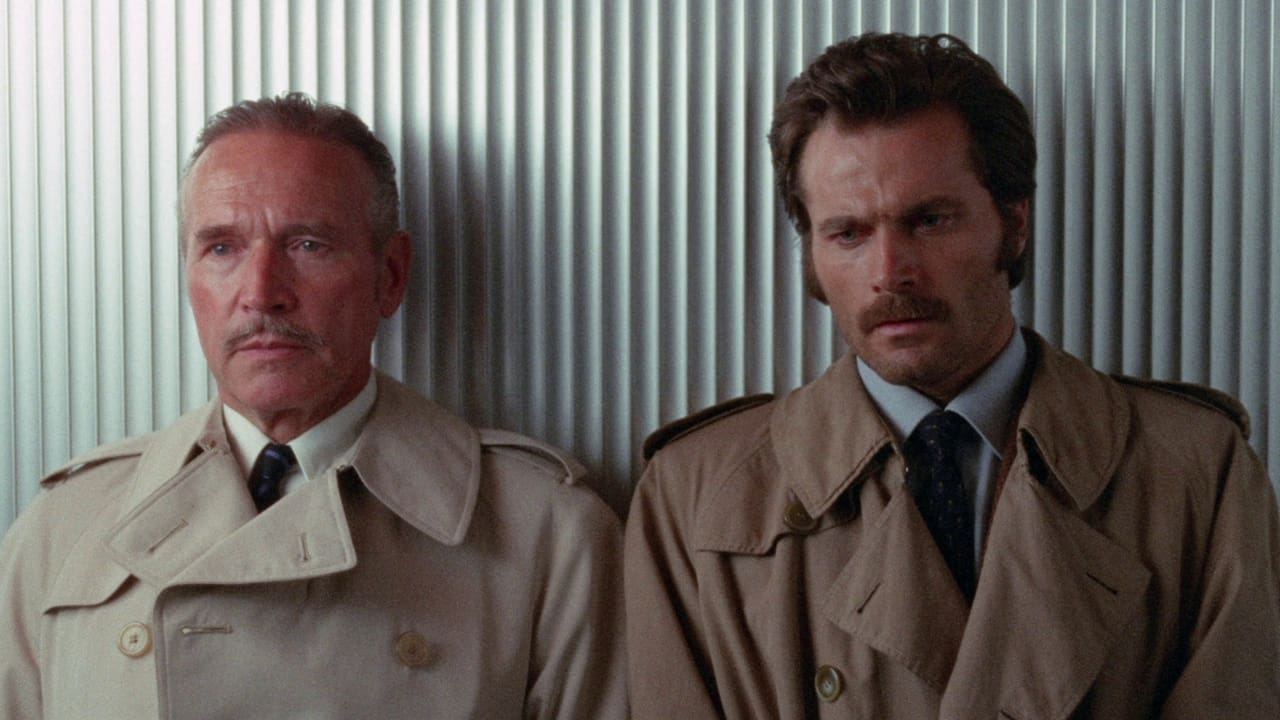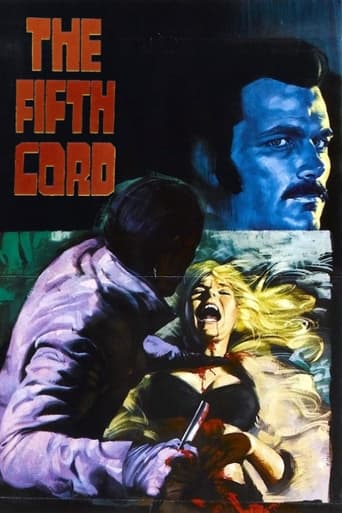

This ridiculously well-made Giallo stars Franco Nero as an alcoholic journalist drawn into a series of murder of which he himself is a suspect! We initially start with a new years eve party where we are introduced to many of our main characters and their complicated relationships: Nero and his on-off girlfriend, a disabled woman and her distant husband, a lady, her new lover, and jealous ex. One of the party goers is attacked in a tunnel with an iron bar which is witnessed by a race car driver and his hooker girlfriend, and it's while Franco Nero is investigating this that the crippled lady is strangled and thrown down a flight of stairs. A glove with one finger missing seems to indicate a killer is around and we haven't seen that last of them...There's an amazing atmosphere about this film due to the cinematography and the general tone of what your watching. Most of the film is shot in room where harsh light shines through blinds or folks stand in front of bright light sources. The only colours on display are white, grey, black and green, and there's a fair amount of use of Chiaroscuro. There's also a bizarre focus on spiral staircases, and the atonal Ennio Morricone soundtrack adds to the paranoia.As per usual, Franco Nero is beyond belief in his role, being a drunk with a chip on his shoulder, but the biggest surprise for me was when the killer decided to focus on a small child as his latest victim, which led to some very tense scenes as the child tried to protect the house from intruders while his mum was listening on the phone, a helpless distance away. Great film, this one.
... View More****SPOILERS**** Great atmospherics keeps the movie "The Fifth Cord" from putting its audience to sleep with the plot at times making no sense at all as well as those who ended up being murdered in it. It all started at a New Years Eve party where all of the victims as well as their killer were attending. It's downtrodden and drunk reporter Andrea Bild,Franco Nero, or Mister Bill as he's called all throughout the film who ends up doing the work that the local police are supposed to do in finding the killer. The deranged killer who mails audio recordings to the police about his crimes as well as amputate the fingers of his victims in some kind of sick rituals on his part.There's also Mister Bill's estranged wife Helena, Silvia Monti, who by her standing by her man-Mister Bill-despite all the abuse she takes from him makes her a target of the masked, with what looked like a sock pulled over his head, killer. It's Mister Bill who soon discovers that only the people who attended that New Years Eve Party were the ones who ended up being murdered with their fingers chopped off by their killer. What'e even more amazing is that the killer for some strange reason choose Tuesday as the day of the week to murder them! It takes a while for Mister Bill to realize who the killer is but by then it's almost too late for him. That's when the masked killer ends up crashing into his wife's house and threatening to not only murder her but her 6 years old son Tony as well! ****SPOILERS***** With her estranged husband Mister Bill coming to her and Tony's rescue the killer who seemed to have, like a trapezes artist, excellent acrobatic abilities turned out to be a hard nut to crack or catch. That's until he lost his footing and fell down some 50 feet from the deserted factory loft landing flat on his back. It's then that we discover who the hell he or for a moment, with what looked like his face heavily and cosmetically made up, she is. And as we and Mister Bill also learn is that all his killings were for sheer revenge. But to throw the police and Mister Bill off his tracks he murdered four other persons who had nothing at all to do with his hang-up, the person who set the crazy guy off, only just to try to cover his tracks.
... View MoreAs far as I am concerned, the Italian Giallo is (along with old-fashioned Gothic tales) the most elegant and intriguing sub-genre the great genre of Horror has ever brought forth. Especially the early 70s have brought forth several Gialli that range among the most compelling Horror/Suspense films ever made, such as "What Have They Done To Solange", "Don't Torture A Duckling", "The Red Queen Kills Seven Times" or "Your Vice Is A Locked Room And Only I Have The Key" (all made in 1972), just to name a few. Luigi Bazzoni's "Giornata Nera Per L'Ariete" aka. "The Fifth Cord" (1971) is a beautiful and stylish example for the elegance of the early 70s Giallo, but it isn't quite an example for the intriguing and suspenseful character of the genre. While "The Fifth Cord" is amazingly photographed, brilliantly scored and greatly acted, it is very slow, and simply doesn't compare to the suspense of many contemporary Gialli. This is not to say that it is a bad film; as my rating suggests, it is actually more than decent. There are many downright brilliant early 70s Gialli, however, and this one simply isn't one of them.Franco Nero stars as Andrea Bild, an alcoholic and womanizing journalist who decides to investigate a murder series on his own... The film starts promising with a tape recording of a warped voice, vowing to murder several people with no apparent reason. What begins as a typical Giallo-plot is executed with a very slow pace, and often drifts into melodrama instead of building up thrills. Franco Nero is one of my all-time favorite actors, and he once again delivers a great performance here. However, Nero's character in this film isn't very likable, which makes it difficult to sympathize with him. It often seems as if Bazzoni wasn't sure whether to make his protagonist a drunken macho or a sensitive romantic - which results in Franco Nero threatening colleagues and slapping around his girlfriend at one point, and sobbing at the door of his former girlfriend one minute later. The supporting cast includes several well-known regulars of Italian Genre cinema, such as Guido Alberti, Silvia Monti and Ira von Fürstenberg. The murders are quite unspectacular for Giallo-standards. The score is mesmerizing, however, and the cinematography is beautiful. This is the second film by Luigi Bazzoni that I saw, the other being "L'Uomo, L'Orgoglio, La Vendetta" ("Man, Pride And Vengeance", 1968), a Spaghetti Western version of the novel "Carmen", that is set in Spain and, therefore, strictly speaking not a Western. Both films are stylish and more than decent, but neither of them is a particularly recommendable specimen of their genre. "The Fifth Cord" is definitely worth watching for my fellow Giallo-fans, but, in my opinion, it is by no means a must-see and there's a vast amount of Gialli that should be seen before this one.
... View MoreMuch of The Fifth Cord is what I would call average for a Giallo. The death scenes aren't that original, the murder investigation is often muddled and confusing, and, other than Franco Nero, I've seen far better acting in other Gialli. As for the mystery elements, The Fifth Cord doesn't really play fair. It seems all but impossible for the average viewer to figure out "who done it" based on the clues presented. Finally, the score is one of the more non-memorable pieces from Ennio Morricone I've heard recently.But it's not all bad. In fact, when The Fifth Cord is good, it's very good. First, there's the look of the film. Director Luigi Bazzoni and Cinematographer Vittorio Storaro have successful made one of the best looking Gialli I've seen. Through a combination of brilliant framing, lighting, and location choices, almost every frame is like a work of art. There are some remarkable uses of light and shadows that are simply stunning. Second, the final scenes are as tense as any of the better known Gialli I've seen. It's real "on the edge of your seat" kind of stuff. Third, Franco Nero is a real professional and does a lot to bring life and realism to his role. I always enjoy his performances.Overall, The Fifth Cord may not be the best Giallo in the world, but for fans of the genre, there's enough here to enjoy to make the film worthwhile. Also, today's filmmakers could learn a thing or two about making a film really standout visually from watching what Bazzoni and Storaro did in The Fifth Cord.
... View More